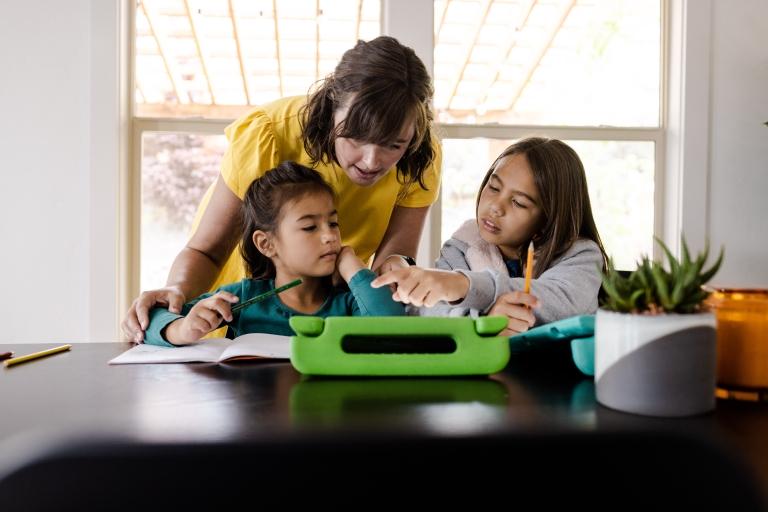
A student's success is supported by quality schools, invested educators, and engaged families. Outside the classroom, students rely on their families to drive support for their education and learning opportunities. Studies show that family and guardian engagement has positive effects on student outcomes. This encourages teachers to build and maintain healthy relationships with their families.
“Beyond day-to-day communication, building meaningful connections with students and families improves morale and provides a solid foundation for learning outside of the classroom. Knowing that learning doesn’t stop when the school day ends, it’s important to ensure students receive the continual support they need to succeed.” - The State of Teaching and Learning in K-12 Education
Students benefit from families that are actively involved in their education and academic environment. Here are some ways family engagement can positively impact student success:
- Improved Academic Performance: Students progress academically when guardians monitor and engage with their studies.
- Better Attendance: Students attend school regularly and on time when guardians enforce a schedule and routine.
- Improved Behavior: Students develop social and emotional regulating skills when families reinforce positive behaviors and provide support in challenging situations.
- Increased Confidence: Students who are supported by their families are more likely to reach for their goals and believe in themselves.
- Better Communication: Students learn how to communicate and advocate for themselves when guardians regularly check their academic progress.
Teachers can assist in driving family engagement, further supporting the student. Check out our ten strategies to boost family engagement in the classroom.
1. Host Open Houses and Class Tours
Back-to-school open houses allow you to set a positive tone for the school year and initiate healthy relationships with your students' families. Use this time to establish a personal connection and allow students and their families to get an understanding of your personality, teaching style, and expectations. Remember you’re meeting them as well; begin to build trust by getting to know your families and allowing them to ask questions or express concerns.
2. Send Scheduled Newsletters
A scheduled newsletter can keep families informed on classroom expectations, what their students are learning, and upcoming assignments. Newsletters can also be a resource to express class needs, inform parents of the latest school events, and provide additional information. Remember to set a schedule for newsletters, whether weekly, monthly, or semester-based. Consistency is key, and your families will appreciate your effort.
3. Be Accessible
Communication is key as you look to increase family involvement. Be sure all families know how to contact you for updates concerning the student, questions, and even concerns. On the flip side, it's also important that you can get in contact with them.
With advancing technology and tools in the classroom, teachers now have multiple ways to drive communication. The classroom phone, teacher email, and face-to-face communication are traditional and dependable forms of communication. However, an LMS supports a convenient and flexible way for families to connect with chats, notifications, and calendar reminders.
Use other digital tools and apps to engage your families. For instance, a video chat application such as Zoom can make scheduling and hosting parent-teacher conferences more accessible. Consider creating a classroom website, social media page, or podcast to offer additional access to class resources and foster connection.
4. Welcome Volunteering and Assistance
Sometimes, you may need additional classroom help for class events, field trips, or other special occasions. Provide an accessible volunteer list where families can find current opportunities. When families offer a helping hand, ensure they have clear instructions and can actively engage with the class.
5. Offer Homework and Project Support
When teaching new or complex concepts, keep families informed so they are equipped to support students outside of the classroom. Families appreciate having the tools to offer academic assistance for homework and projects. Provide guides, tutorials, rubrics, and other additional resources.
6. Encourage Parent Workshops and Sessions
Parent and family workshops are another way to inform families about the latest teaching practices, concepts, and technologies. These workshops are family-specific, addressing parental concerns and needs. Families learn how to best advocate for their students and give back to the school. Encourage families to take advantage of these resources, adding value to the school’s ecosystem.
7. Promote School and Community Events
Hosting events like school fairs, fundraisers, enrichment programs, and career days brings the entire community together. Use community events to collaborate and engage with your families. Families can also use these events to network with one another, building bonds that benefit students. Remember to notify families of school events beforehand, ensuring their informed and increasing event turnout.
8. Organize Inclusive Class Celebrations
Remember to consider your student's cultural and religious backgrounds when hosting celebrations. Ensure all students can participate, or accommodations can be made for class parties. For example, teachers may throw a winter party instead of a holiday party to accommodate students with different customs and beliefs. The goal is to ensure that all students and families can participate in class celebrations.
9. Showcase Student Work
Keep students' work on display, sharing what students have accomplished and celebrating their achievements. Families enjoy seeing what activities their students are engaging in. Use student work as a conversation starter, sharing what the students learned and the next steps in their learning journeys.
Showcasing student work gives them a sense of belonging, reminding them they are an essential part of their learning community. Welcome your families to view the latest student work, keeping the classroom updated with engaging content and activities.
10. Encourage Family Feedback
See how you can better serve your students and families with surveys. Soliciting family feedback encourages a partnership and gives families a voice in their student's academic life. Remember that teaching is a journey, and feedback facilitates improvement. Families would appreciate your accountability as you welcome their honesty and transparency.
Increasing Family Engagement with an LMS
An LMS plays a pivotal role in enhancing family engagement, bridging the gap between home and school, and empowering parents to become active partners in their child's education. A learning management system like Canvas LMS supports connections between teachers, students, and their families. Parents can monitor their child's progress, view assignments, communicate with educators, and access resources and learning materials, ensuring they remain actively involved in their child's education. This transparency keeps parents informed and empowers them to offer timely support and encouragement.
It can be challenging for a student’s support system to keep up with their learning by simply looking over their shoulder at their coursework. Instead, invite guardians to have a seat at the table by allowing them to monitor their student’s learning from afar using mobile applications and course notifications. Encourage families to download the Canvas Parent App, where they can monitor and engage with their student's learning journey. Don’t forget to offer a tutorial to guide them through the app.
Learn more about engaging families and guardians with Canvas LMS.
Related Content
 Teaching-With-Tech-10-Benefits.jpg
Teaching-With-Tech-10-Benefits.jpgBlogs
 creds-retention.jpg
creds-retention.jpgBlogs
 cidilabs.png
cidilabs.pngBlogs
